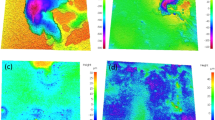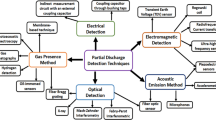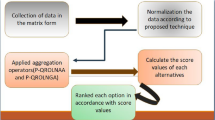Abstract
In this work, we have proposed a neutrosophic statistical approach for the analysis of resistance of conducting material depending on the temperature variance. We have developed a neutrosophic formula and applied it to the resistance data. We also use the classical statistical approach for making a comparison between both approaches. As a result, it is observed that the neutrosophic statistical approach is more flexible and informative. Also, this work suggests that the neutrosophic statistical approach analyzes the resistance of conducting material for big data.
Similar content being viewed by others
Introduction
The electric properties of conducting material are studied mostly by analyzing the resistance variation. Generally, it is seen that the change in resistance variation of conducting material depends on temperature variation i.e. with an increase in the temperature ‘\(\Delta T\)’ the resistance of the conducting material ‘\(\Delta R\)’also increase1.
Because with an increase in temperature the vibrational motion of the atoms and molecules of conducting material increases, which becomes the reason for the electronic and atomic collision. As a result, the resistance of the conducting material increases. A number of researchers have worked on the resistance w.r.t temperature of different materials like graphene, carbon, and others, as can be seen in the following references2,3,4,5,6.
The resistance of the material can be measured through numerous methods7,8 as well as devices and data may be fixed-point values (determined values) or interval point values (undetermined values). This measured data can analyze through different statistical approaches. Generally, for fix point values i.e. when data has exact observation and imprecise, the classical statistical approach has been used9. For the interval point values i.e. having uncertainty, we cannot apply this approach. Fuzzy statistical logic was proposed by10, which deals with uncertain data10.
Smarandache introduced a reliable statistical approach is known as the neutrosophic statistical approach11, which is a more efficient and generalized form of the fuzzy statistical approach. Recently, neutrosophic approach use has been increased for the analysis of the interval data in a number of fields i.e. in applied sciences12, in medicine for diagnoses data measurement13, in astrophysics for measurement of earth speed data14 and in humanistic15. Reference16 used the K-means of the neutrosophic approach to analyze the data of the earthquake. Neutrosophic sampling was used by17 to study the limitation of health care for diagnosis. Similarly, the neutrosophic Kruskal–Wallis H test was used to analyze the data of COVID-19 by18. More information on the applications of neutrosophic logic in various fields can be seen in17,19,20,21.
The neutrosophic approach is used for the analysis of interval point value data i.e. having indeterminacy9 and has substantial benefit over the classical approach; because the classical statistic approach only deals with fix point value data i.e. having no indeterminacy. Moreover, the neutrosophic technique is more helpful than the classical technique. For example, the neutrosophic binomial distribution explains acceptance, rejection as well as indeterminate probabilities but on the other hand, classical binomial distribution only explains acceptance and rejection probabilities22. Similarities for more examples see following references23,24,25. Different statistical techniques were developed under neutrosophic statistics by Muhammad Aslam26,27.
The data of resistance with respect to change in temperature is measured in intervals. In the existing method, an average value of each interval is computed and used to study the relationship between resistance and temperature. By exploring the literature and according to the best of our knowledge, there is no work on studying these variables using neutrosophic statistics. In this paper, we will introduce neutrosophic statistics to analyze the resistance with respect to change in temperature data. We will compare the performance of the proposed method with the existing method under classical statistics. We expect that the proposed method will be efficient, effective and adequate to be applied for resistance with respect to change in temperature data.
Methodology
Let \({X}_{iN}\) is the neutrosophic numbers having \({X}_{iL}\) lower values and \({X}_{iU}\) higher values, so the neutrosophic formula for the ith interval:
Here, IN ∈ [IL, IU] & XN ∈ [XL, XU] is a random neutrosophic variable having size nN ∈ [nL, nU]. The variable XiN ∈ [XiL, XiU] has two parts: lower value XiL a classical part, and upper-value XiUIN an indeterminate part having indeterminacy interval IN ∈ [IL, IU].
Similarly, neutrosophic mean \(\overline{X }\)N \(\in\) [\(\overline{X }\)L, \(\overline{X }\)U] is defined as follows:
Here, \({\overline{X} }_{U}={\sum }_{i=1}^{nL}({X}_{iL} / {n}_{L})\) and \({\overline{X} }_{L}={\sum }_{i=1}^{nU}({X}_{iU} / {n}_{U})\)
As we are studying the change in resistance of a conducting material w.r.t. variation in temperature, so we can write the resistance as the function of the temperature i.e. R(T). Now, let R(T)N is measured interval value of the resistance i.e. R(T)N ∈ [R(T)L, R(T)U], here, R(T)L and R(T)L are the lower and upper values of the interval, respectively. The neutrosophic formula for resistance of the conducting material is written as follows:
From the above resistance formula R(T)N ∈ [R(T)L, R(T)U] is an extension under the classical. The equation is containing two parts i.e. R(T)L determined & R(T)UIN indeterminate part. Moreover, IN ∈ [IL, IU] is known as an indeterminacy interval. Also, the measured resistance interval R(T)N ∈ [R(T)L, R(T)U] can be reduced to the classical or determined part if we choose IL = 0. For classical analysis we use the classical average formula as given below:
Experiment
The main purpose of this research work is to express the advantages of neutrosophic a statistical approach for the analysis of measured resistance data with respect to (w.r.t) temperature variation of the conducting material. For this purpose, we have used a sample 200 nm thin film of a conducting material whose resistance values are measured at 100 Hz w.r.t. to change temperature through the LCR meter in intervals. The characterization setup is as shown in Fig. 1.
The measurement of the values has been performed in intervals i.e. at specific temperature value the maximum and minimum value change of resistance [min; max]. As we measured values in the interval, so for classical analysis, we convert these values into fix point. For using the neutrosophic approach, we first make a neutrosophic formula for resistance and then use this interval data for analysis.
Results and discussion
The measured resistance values of the sample w.r.t change in temperature from 0 to 350 K (these values are not measured from experiment but by concerning the previous work on the resistance w.r.t temperature as in references28,29) as shown in Table 1.
Analysis of data through neutrosophic and classical approach:
After measuring these values, we applied the neutrosophic method. For example, we have observed the first interval value of resistance [0.120; 0.143] at 0 K temperatures. Here R(T)L is 0.120 and R(T)U is 0.143. Similarly, indeterminacy IL = 0 as reason has been mentioned above and IU can find with formula IU = (R(T)U − R(T)L)/R(T)U. So, the value of IU at a given resistance interval is 0.161. The neutrosophic form for the above capacitance interval is written as:
For equation, one can select IN = 0 for getting minimum value i.e. 0.120 or IN = 0.161 for maximum value i.e. 0.143 and if choose any other value between [0, 0.161] for getting a value between the maximum and minimum value. Similarly, we can apply the neutrosophic statistics approach on all other the measured values of resistance w.r.t temperature changing from 0 to 350 K. For example, we have observed the value of resistance [0.120; 0.143] at 0 K temperatures. As it is in interval form, so we convert it into fixed point value i.e. 0.1315 by using the existing classical method.
Comparison between classical statistical approach and neutrosophic statistical approach
In this section, we will compare the efficiency of the proposed method over the existing classical method in terms of a measure of indeterminacy, information and flexibility. The neutrosophic data and data using the classical method are shown in Table 2. The analysis using the resistance changing with respect to temperature variance data are shown in Table 2.
From Table 2, it can be seen that in the classical method a fixed value is calculated on the basis of the average of each interval. Therefore, the classical analysis provides only one value at the time against a specific temperature for the conducting material. The classical method may mislead the decision-makers when extreme values are present in the intervals. On the other hand, the neutrosophic analysis used imprecise values and give information about the measure of indeterminacy. For example, when the temperature is 0 K, the classical analysis gives the value R(0) = 0.132. On the other hand, the proposed method provides the neutrosophic form R(0) = 0.120 + 0.143IN. According to the proposed method, the values of R(0) will be between 0.12 to 0.143 with measure of indeterminacy that is 0.023. By comparing both methods, it can be concluded that the existing method in Physics gives only information about the average value of the interval. On the other hand, the proposed method is quite flexible and adequate to be applied for the interval data.
Now, we compare the proposed method with the classical method graphically. Let us draw the graphs for classical and neutrosophic analysis as shown in Fig. 2. From these graphs, it can be seen that graph of classical analysis is not much flexible because this graph is drawn at fix point values i.e. there is no indeterminacy. The graph using the proposed method is also shown in Fig. 2 which shows more flexibility. This means that the proposed method is more effective to analyze the resistance of the conducting material. From the graph, the information about the resistance at a specific value can be obtained with additional information about the measure of indeterminacy. Also, Fig. 2 shows that the neutrosophic approach is a generalization of the classical method as the curve using the classical method lies between the curves of the proposed method. As a result, it is found that neutrosophic statistics is informative, flexible and adequate than classical statistics.
Conclusions
In this paper, the electrical property of the conducting material through resistance containing indeterminacy i.e. interval values have been analyzed. The neutrosophic statistical approach is used to analyze the interval values and the classical statistical approach is used to analyze the fix point values. From this study, it can be concluded that the analysis of resistance with respect to temperature of conducting material through the neutrosophic statistics approach is more informative, flexible and adequate than the analysis through classical statistics. Moreover, the proposed analysis suggests the use of a neutrosophic statistical approach for big data analysis as part of future research.
Data availability
The data is given in the paper.
References
Frenzel, L. E. Crash Course in Electronics Technology 2nd edn. (Newnes, 1997).
Han, J.-C. & Wang, B.-L. Thermal shock resistance of ceramics with temperature-dependent material properties at elevated temperature. Acta Mater. 59, 1373–1382 (2011).
Luo, C., Jiao, T., Gu, J., Tang, Y. & Kong, J. Graphene shield by SiBCN ceramic: A promising high-temperature electromagnetic wave-absorbing material with oxidation resistance. ACS Appl. Mater. Interfaces. 10, 39307–39318 (2018).
Van Garderen, N., Clemens, F. J., Mezzomo, M., Bergmann, C. P. & Graule, T. Investigation of clay content and sintering temperature on attrition resistance of highly porous diatomite based material. Appl. Clay Sci. 52, 115–121 (2011).
Khounsary, A. M., Chojnowski, D., Assoufid, L. & Worek, W. M. High Heat Flux and Synchrotron Radiation Beamlines 45–51 (International Society for Optics and Photonics, 1997).
Liu, D., Luo, Y. & Shang, X. Experimental investigation of high temperature thermal contact resistance between high thermal conductivity C/C material and Inconel 600. Int. J. Heat Mass Transf. 80, 407–410 (2015).
Shahzad, F., Iqbal, A., Kim, H. & Koo, C. M. 2D transition metal carbides (MXenes): Applications as an electrically conducting material. Adv. Mater. 32, 2002159 (2020).
Hong, R.-B., Wu, J.-R. & Cai, H.-B. Low-temperature crack resistance of coal gangue powder and polyester fibre asphalt mixture. Constr. Build. Mater. 238, 117678 (2020).
Aslam, M. A study on skewness and kurtosis estimators of wind speed distribution under indeterminacy. Theoret. Appl. Climatol. 143, 1227–1234 (2021).
Grzegorzewski, P. Testing statistical hypotheses with vague data. Fuzzy Sets Syst. 112, 501–510 (2000).
Smarandache, F. Introduction to Neutrosophic Measure, Neutrosophic Integral, and Neutrosophic Probability (Infinite Study, 2013).
Christianto, V., Boyd, R. N. & Smarandache, F. Three Possible Applications of Neutrosophic Logic in Fundamental and Applied Sciences (Infinite Study, 2020).
Ye, J. Improved cosine similarity measures of simplified neutrosophic sets for medical diagnoses. Artif. Intell. Med. 63, 171–179 (2015).
Aslam, M. Enhanced statistical tests under indeterminacy with application to earth speed data. Earth Sci. Inform. 14, 1261–1267 (2021).
Smarandache, F. The Neutrosophic Research Method in Scientific and Humanistic Fields (The College of Information Sciences and Technology, 2010).
Ricardo, J. E., Menéndez, J. J. D., Arias, I. F. B., Bermúdez, J. M. M. & Lemus, N. M. Neutrosophic K-means for the analysis of earthquake data in Ecuador. Neutrosophic Sets Syst. 44, 255–262 (2021).
Chico, M. G. G., Bandera, N. H., Lazo, S. H. & Sailema, N. L. Assessment of the relevance of intercultural medical care. Neutrosophic sampling. Neutrosophic Sets Syst. 44, 420–426 (2021).
Sherwani, R. A. K., Shakeel, H., Awan, W. B., Faheem, M. & Aslam, M. Analysis of COVID-19 data using neutrosophic Kruskal Wallis H test. BMC Med. Res. Methodol. 21, 1–7 (2021).
El Barbary, O. G. & Abu Gdairi, R. Neutrosophic logic-based document summarization. J. Math. 2021, 1–7 (2021).
Duan, W.-Q., Khan, Z., Gulistan, M. & Khurshid, A. J. C. Neutrosophic exponential distribution: Modeling and applications for complex data analysis. Complexity 2021, 1–8 (2021).
Gulistan, M., Elmoasry, A. & Yaqoob, N. $${\mathcal N} $$ N-version of the neutrosophic cubic set: Application in the negative influences of Internet. J. Supercomput. 77, 11410 (2021).
Aslam, M. A new attribute sampling plan using neutrosophic statistical interval method. Complex Intell. Syst. 5, 365–370 (2019).
Smarandache, F. Introduction to Neutrosophic Statistics: Infinite Study (Romania-Educational Publisher, 2014).
Chen, J., Ye, J. & Du, S. Scale effect and anisotropy analyzed for neutrosophic numbers of rock joint roughness coefficient based on neutrosophic statistics. Symmetry 9, 208 (2017).
Chen, J., Ye, J., Du, S. & Yong, R. Expressions of rock joint roughness coefficient using neutrosophic interval statistical numbers. Symmetry 9, 123 (2017).
Aslam, M. Design of the Bartlett and Hartley tests for homogeneity of variances under indeterminacy environment. J. Taibah Univ. Sci. 14, 6–10 (2020).
Aslam, M. On detecting outliers in complex data using Dixon’s test under neutrosophic statistics. J. King Saud Univ. –Sci. 32, 2005–2008 (2020).
Bid, A., Bora, A. & Raychaudhuri, A. Temperature dependence of the resistance of metallic nanowires of diameter ⩾ 15 nm: Applicability of Bloch-Grüneisen theorem. Phys. Rev. B 74, 035426 (2006).
Elguindi, J., Wagner, J. & Rensing, C. Genes involved in copper resistance influence survival of Pseudomonas aeruginosa on copper surfaces. J. Appl. Microbiol. 106, 1448–1455 (2009).
Acknowledgements
The authors are deeply thankful to the editor and reviewers for their valuable suggestions to improve the quality and presentation of the paper.
Author information
Authors and Affiliations
Contributions
U.A., H.A., N.A., M.A. wrote the paper.
Corresponding author
Ethics declarations
Competing interests
The authors declare no competing interests.
Additional information
Publisher's note
Springer Nature remains neutral with regard to jurisdictional claims in published maps and institutional affiliations.
Rights and permissions
Open Access This article is licensed under a Creative Commons Attribution 4.0 International License, which permits use, sharing, adaptation, distribution and reproduction in any medium or format, as long as you give appropriate credit to the original author(s) and the source, provide a link to the Creative Commons licence, and indicate if changes were made. The images or other third party material in this article are included in the article's Creative Commons licence, unless indicated otherwise in a credit line to the material. If material is not included in the article's Creative Commons licence and your intended use is not permitted by statutory regulation or exceeds the permitted use, you will need to obtain permission directly from the copyright holder. To view a copy of this licence, visit http://creativecommons.org/licenses/by/4.0/.
About this article
Cite this article
Afzal, U., Alrweili, H., Ahamd, N. et al. Neutrosophic statistical analysis of resistance depending on the temperature variance of conducting material. Sci Rep 11, 23939 (2021). https://doi.org/10.1038/s41598-021-03347-z
Received:
Accepted:
Published:
DOI: https://doi.org/10.1038/s41598-021-03347-z
This article is cited by
-
Saddlepoint p-values for a class of location-scale tests under randomized block design
Scientific Reports (2024)
-
Group decision making in the analytic hierarchy process by hesitant fuzzy numbers
Scientific Reports (2023)
-
Assessment of lead, cadmium, and mercury levels in the breast milk in Pakistani women
Environmental Science and Pollution Research (2023)
-
Effects of dam on temperature, humidity and precipitation of surrounding area: a case study of Gomal Zam Dam in Pakistan
Environmental Science and Pollution Research (2022)
Comments
By submitting a comment you agree to abide by our Terms and Community Guidelines. If you find something abusive or that does not comply with our terms or guidelines please flag it as inappropriate.





